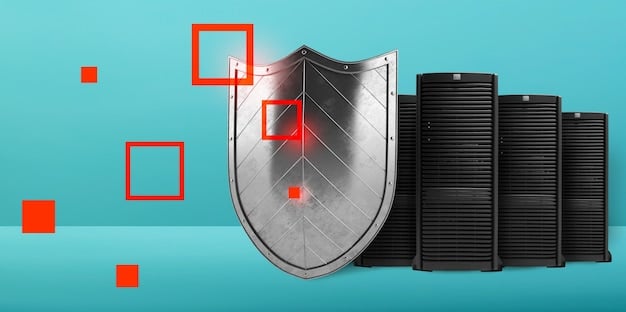Startup Cybersecurity: Protecting Your Company from Cyber Threats in 2025

Startup cybersecurity in 2025 requires proactive measures, including threat intelligence, employee training, robust incident response plans, and compliance frameworks, to effectively protect companies from evolving cyber threats and ensure operational resilience.
In today’s digital landscape, **startup cybersecurity: protecting your company from cyber threats in 2025** is not just a concern; it’s an absolute necessity. As startups increasingly rely on technology for their operations, they become prime targets for cyberattacks.
Understanding the Evolving Threat Landscape for Startups
The cybersecurity threat landscape is constantly evolving, and startups need to be aware of the latest threats to protect themselves. Understanding these threats is the first step in building a robust security posture.
Startups are particularly vulnerable to cyberattacks due to limited resources and expertise. Here are some of the most common threats startups face in 2025:
Ransomware Attacks
Ransomware continues to be a significant threat, with attackers encrypting critical data and demanding payment for its release. Startups are often targeted because they may not have robust backup and recovery systems in place.
Phishing and Social Engineering
These attacks target employees, tricking them into revealing sensitive information or installing malware. They exploit human vulnerabilities rather than technical weaknesses.
Cloud Vulnerabilities
Many startups rely heavily on cloud services, which can introduce new vulnerabilities if not properly configured and managed. Misconfigurations and inadequate access controls are common issues.

Insider Threats
Whether malicious or accidental, insider threats can cause significant damage. Employees with access to sensitive data can pose a risk if they are not properly vetted and trainedon security protocols.
- Implement multi-factor authentication: Require more than just a password to access critical systems.
- Regularly update software: Patch vulnerabilities promptly to prevent exploitation.
- Train employees: Educate your team about phishing and other social engineering tactics.
- Monitor network activity: Detect and respond to suspicious behavior quickly.
By understanding these threats, startups can better prepare themselves to defend against them. It’s crucial to stay informed about the latest cybersecurity trends and adapt security measures accordingly.
In conclusion, the evolving threat landscape requires startups to be vigilant and proactive in their cybersecurity efforts. Staying informed and implementing robust security measures is essential for protecting valuable assets.
Building a Strong Cybersecurity Foundation
A strong cybersecurity foundation is crucial for protecting a startup’s assets and maintaining customer trust. This involves implementing a comprehensive set of security measures that address various potential risks.
Building a solid foundation requires a combination of technology, processes, and policies. Here are some key elements to consider:
Risk Assessment
Start by identifying and assessing potential risks. This involves evaluating the likelihood and impact of various threats to determine where to focus security efforts.
Security Policies and Procedures
Develop clear and comprehensive security policies that outline acceptable use of technology, data handling procedures, and incident response protocols.
Network Security
Implement firewalls, intrusion detection systems, and virtual private networks (VPNs) to protect your network from unauthorized access.

Data Encryption
Encrypt sensitive data both in transit and at rest to protect it from unauthorized access. Use strong encryption algorithms and manage encryption keys securely.
Access Control
Implement strict access control policies to ensure that only authorized personnel have access to sensitive data and systems. Use the principle of least privilege to limit access to what is necessary.
- Regularly review and update policies: Keep your security policies current and relevant.
- Conduct regular security audits: Identify vulnerabilities and assess the effectiveness of security measures.
- Backup data regularly: Ensure that you have reliable backups in case of data loss or ransomware attacks.
By building a strong cybersecurity foundation, startups can significantly reduce their risk of falling victim to cyberattacks. This requires a proactive approach and a commitment to continuous improvement.
In summary, creating a robust cybersecurity foundation involves assessing risks, implementing strong security policies, and using technology to protect networks and data. This foundation is essential for startup survival in the digital age.
Implementing Proactive Security Measures
Proactive security measures are essential for staying ahead of cyber threats and protecting your startup. These measures involve actively seeking out and addressing potential vulnerabilities before they can be exploited.
Being proactive requires a combination of vigilance, monitoring, and continuous improvement. Here are some key proactive security measures to implement:
Threat Intelligence
Stay informed about the latest threats and vulnerabilities by leveraging threat intelligence feeds and security reports. Use this information to proactively identify and address potential risks.
Vulnerability Scanning
Regularly scan your systems and applications for vulnerabilities. Use automated scanning tools to identify potential weaknesses and prioritize patching efforts.
Penetration Testing
Conduct regular penetration tests to simulate real-world attacks and identify vulnerabilities that may not be detected by automated scanning tools. Engage experienced security professionals to conduct these tests.
Security Awareness Training
Continuously train employees on security best practices and emerging threats. Conduct regular phishing simulations to test their awareness and improve their ability to identify and avoid attacks.
- Automate security tasks: Use automation to streamline security processes and reduce the risk of human error.
- Monitor security logs: Regularly review security logs to detect suspicious activity and potential security incidents.
- Stay updated: Keep your security tools and technologies up to date to protect against the latest threats.
By implementing proactive security measures, startups can significantly reduce their risk of falling victim to cyberattacks. This requires a commitment to continuous monitoring, training, and improvement.
In conclusion, proactive security measures involve staying informed about threats, scanning for vulnerabilities, and continuously training employees. These efforts are essential for maintaining a strong security posture.
Leveraging the Cloud Securely
The cloud offers numerous benefits for startups, but it also introduces new security challenges. Leveraging the cloud securely requires careful planning, configuration, and management.
Securing cloud environments involves understanding the shared responsibility model and implementing appropriate security controls. Here are some key considerations:
Shared Responsibility Model
Understand the shared responsibility model, which defines the security responsibilities of the cloud provider and the customer. Typically, the cloud provider is responsible for the security of the infrastructure, while the customer is responsible for the security of data and applications.
Configuration Management
Properly configure cloud services and applications to ensure they are secure. Avoid common misconfigurations, such as leaving default settings unchanged or granting excessive permissions.
Access Control
Implement strong access control policies to restrict access to cloud resources. Use multi-factor authentication and the principle of least privilege to limit access to only what is necessary.
Data Encryption
Encrypt sensitive data stored in the cloud, both in transit and at rest. Use strong encryption algorithms and manage encryption keys securely.
- Monitor cloud activity: Use cloud monitoring tools to detect suspicious activity and potential security incidents.
- Regularly audit cloud configurations: Ensure that cloud services are properly configured and secured.
- Secure APIs: Protect APIs with authentication and authorization mechanisms to prevent unauthorized access.
By leveraging the cloud securely, startups can take advantage of its many benefits while minimizing their risk of cyberattacks. This requires a proactive approach and a commitment to continuous monitoring and improvement.
In summary, securing cloud environments requires understanding the shared responsibility model, proper configuration, access control, and data encryption. These measures are crucial for protecting sensitive data and maintaining a strong security posture.
Incident Response and Recovery Planning
Even with the best security measures in place, incidents can still occur. Having a well-defined incident response and recovery plan is essential for minimizing the impact of security breaches and ensuring business continuity.
Incident response and recovery planning involves preparing for the inevitable and having a plan in place to quickly and effectively respond to security incidents. Here are some key elements to consider:
Incident Response Plan
Develop a comprehensive incident response plan that outlines the steps to take in the event of a security breach. This plan should include roles and responsibilities, communication protocols, and procedures for containing, eradicating, and recovering from incidents.
Data Backup and Recovery
Implement a robust data backup and recovery system to ensure that you can quickly restore data in the event of a data loss or ransomware attack. Regularly test your backup and recovery procedures to ensure they are effective.
Business Continuity Plan
Develop a business continuity plan that outlines how you will maintain critical business functions during and after a security incident. This plan should include alternative processes, communication strategies, and disaster recovery procedures.
Communication Plan
Establish a clear communication plan for keeping stakeholders informed during a security incident. This plan should include who to notify, what information to provide, and how to communicate updates.
- Regularly test your incident response plan: Conduct tabletop exercises and simulations to ensure that your team is prepared to respond effectively to security incidents.
- Automate incident response tasks: Use automation to streamline incident response processes and reduce response times.
- Learn from past incidents: Conduct post-incident reviews to identify areas for improvement and update your incident response plan accordingly.
By developing and testing incident response and recovery plans, startups can minimize the impact of security breaches and ensure business continuity. This requires a proactive approach and a commitment to continuous improvement.
In conclusion, incident response and recovery planning involves preparing for security incidents, developing response plans, and implementing robust backup and recovery systems. These efforts are essential for minimizing the impact of breaches and ensuring business continuity.
Compliance and Regulatory Considerations
Startups often need to comply with various regulations and standards related to data privacy and security. Understanding and adhering to these requirements is essential for avoiding legal and financial penalties.
Compliance and regulatory considerations vary depending on the industry and location of the startup. Here are some key regulations and standards to consider:
GDPR (General Data Protection Regulation)
If your startup processes personal data of individuals in the European Union, you need to comply with GDPR. This regulation requires you to implement specific data protection measures and obtain consent for processing personal data.
CCPA (California Consumer Privacy Act)
If your startup processes personal data of California residents, you need to comply with CCPA. This law gives consumers the right to access, delete, and opt out of the sale of their personal data.
HIPAA (Health Insurance Portability and Accountability Act)
If your startup deals with protected health information (PHI), you need to comply with HIPAA. This law requires you to implement specific security and privacy measures to protect PHI.
PCI DSS (Payment Card Industry Data Security Standard)
If your startup processes credit card payments, you need to comply with PCI DSS. This standard requires you to implement specific security measures to protect cardholder data.
- Conduct regular compliance audits: Ensure that your startup is meeting its compliance obligations by conducting regular audits and assessments.
- Implement data privacy policies: Develop clear and comprehensive data privacy policies that outline how you collect, use, and protect personal data.
- Train employees on compliance requirements: Ensure that your employees are aware of their compliance obligations and understand how to meet them.
By understanding and adhering to compliance and regulatory requirements, startups can avoid legal and financial penalties and build trust with their customers. This requires a proactive approach and a commitment to continuous compliance monitoring.
In summary, compliance and regulatory considerations involve understanding and adhering to data privacy and security regulations such as GDPR, CCPA, HIPAA, and PCI DSS. Compliance is essential for avoiding penalties and building trust.
| Key Point | Brief Description |
|---|---|
| 🛡️ Threat Landscape | Understanding evolving cyber threats like ransomware and phishing. |
| 🔒 Security Foundation | Building a robust foundation with risk assessments and strong policies. |
| ☁️ Cloud Security | Leveraging the cloud securely with proper configurations and access controls. |
| 🚨 Incident Response | Planning for incidents with response and recovery strategies. |
FAQ
▼
Cybersecurity is vital for startups because they often lack resources, making them vulnerable to attacks. A single breach can lead to financial loss, reputational damage, and even closure. Protecting data and systems ensures survival.
▼
Startups face various threats, including ransomware, phishing, cloud vulnerabilities, and insider threats. Ransomware encrypts data, phishing tricks employees, cloud misconfigurations expose data, and insiders can cause breaches intentionally or accidentally.
▼
Startups can build a strong foundation through risk assessments, security policies, network security measures, data encryption, and access control. Regular audits and employee training are also crucial for maintaining a secure environment.
▼
Proactive measures include threat intelligence, vulnerability scanning, penetration testing, and security awareness training. Automating security tasks and monitoring security logs help detect and respond to threats promptly and effectively.
▼
Startups ensure compliance by understanding and adhering to regulations like GDPR, CCPA, HIPAA, and PCI DSS. Implementing data privacy policies, conducting audits, and training employees are essential for meeting compliance obligations.
Conclusion
In conclusion, **startup cybersecurity** in 2025 requires a proactive, multi-faceted approach encompassing threat awareness, robust security foundations, continuous monitoring, and compliance with regulatory standards. By prioritizing these measures, startups can effectively mitigate risks and protect their valuable assets in an increasingly complex digital landscape.





